Eduqas Biology A Level C3 - Transport in Plants
1/77
There's no tags or description
Looks like no tags are added yet.
Name | Mastery | Learn | Test | Matching | Spaced |
|---|
No study sessions yet.
78 Terms
What is the purpose of vascular tissue in plants?
to transport materials around the plant
What is the vascular tissue in plants?
xylem and phloem
In the roots of a plant, the xylem is located...
in the centre, star-shaped and surrounded by phloem
In the roots of a plant, the phloem is located...
in the centre, surrounding the star-shaped xylem
Draw a labelled diagram of a TS root
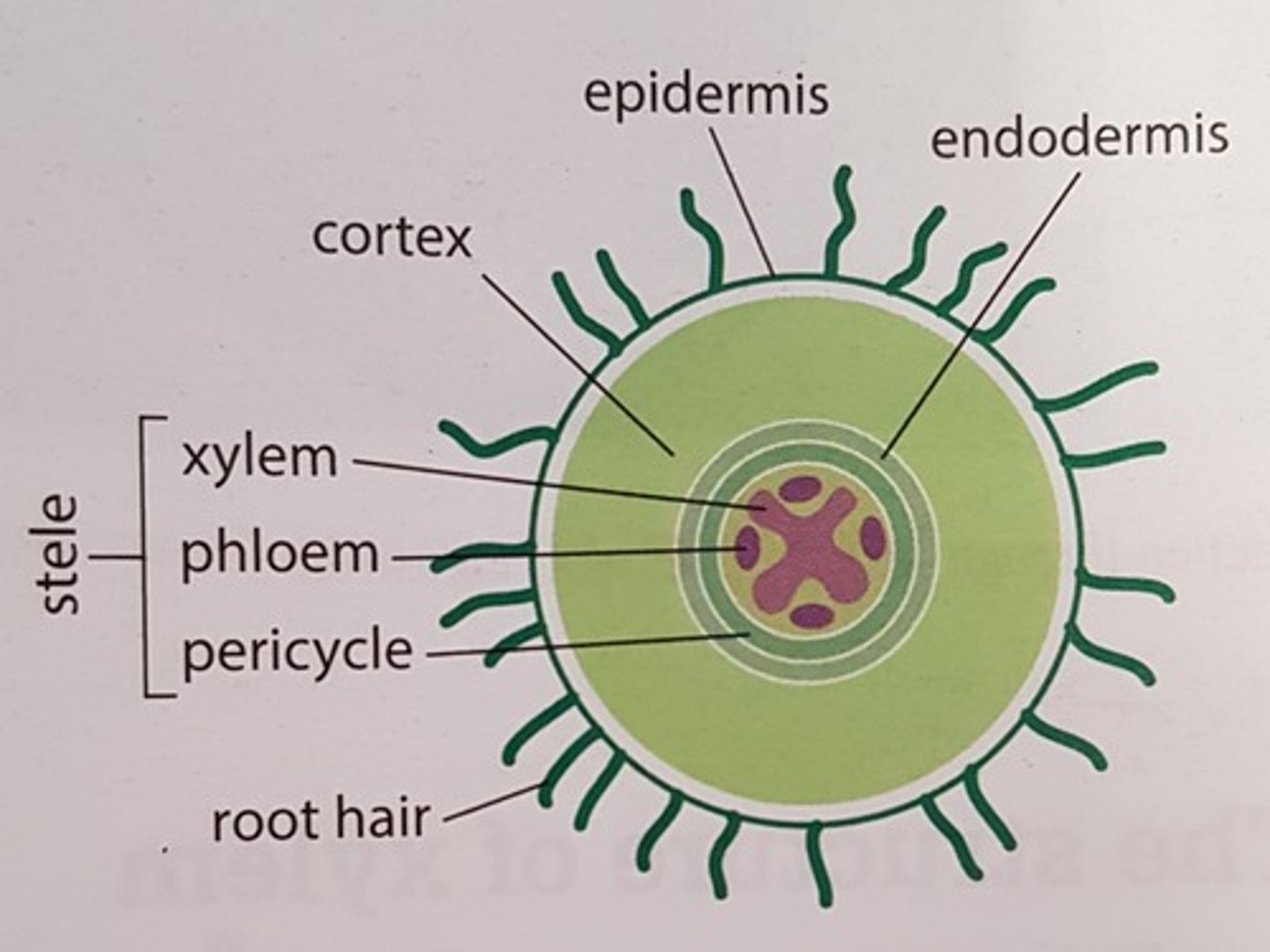
In the stem of a plant, the xylem is located...
in a vascular bundle with the phloem, around the outside of the stem - with the xylem towards the centre
In the stem of a plant, the phloem is located...
in a vascular bundle with the xylem, around the outside of the stem - with the phloem towards the outside
Draw a labelled diagram of a TS stem
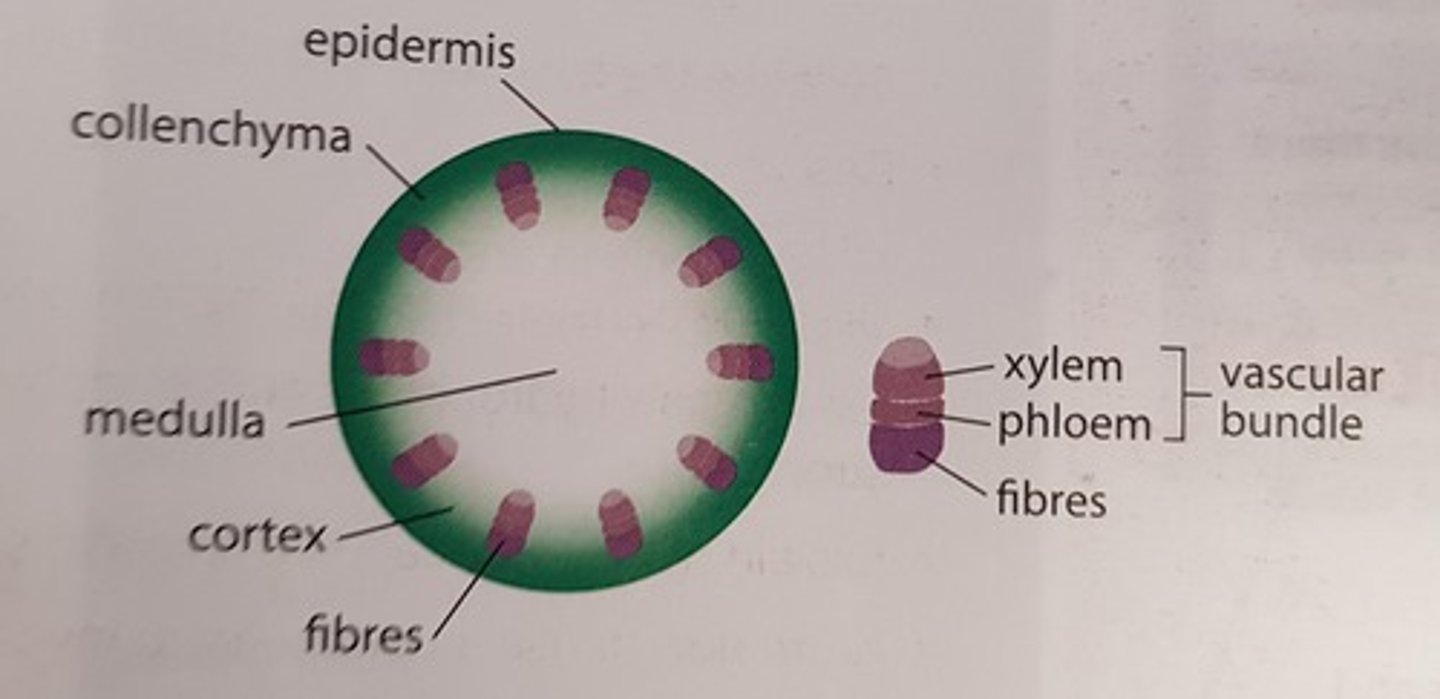
In the leaves of a plant, the xylem is located...
in vascular bundles in the veins of the leaves, with the xylem towards the top of the leaf
In the leaves of a plant, the phloem is located...
in vascular bundles in the veins of the leaves, with the phloem towards the bottom of the leaf
Draw a labelled diagram of a section through a leaf, showing the vascular bundles in the veins

What are the main cell types in the xylem?
vessels and tracheids
What are the two functions of xylem?
- Transport of water and dissolved minerals
- Providing mechanical strength and support
If you look down a microscope at a xylem vessel from the side (section cut parallel to the vessel), what will you see?
Long strips of spiral patterns
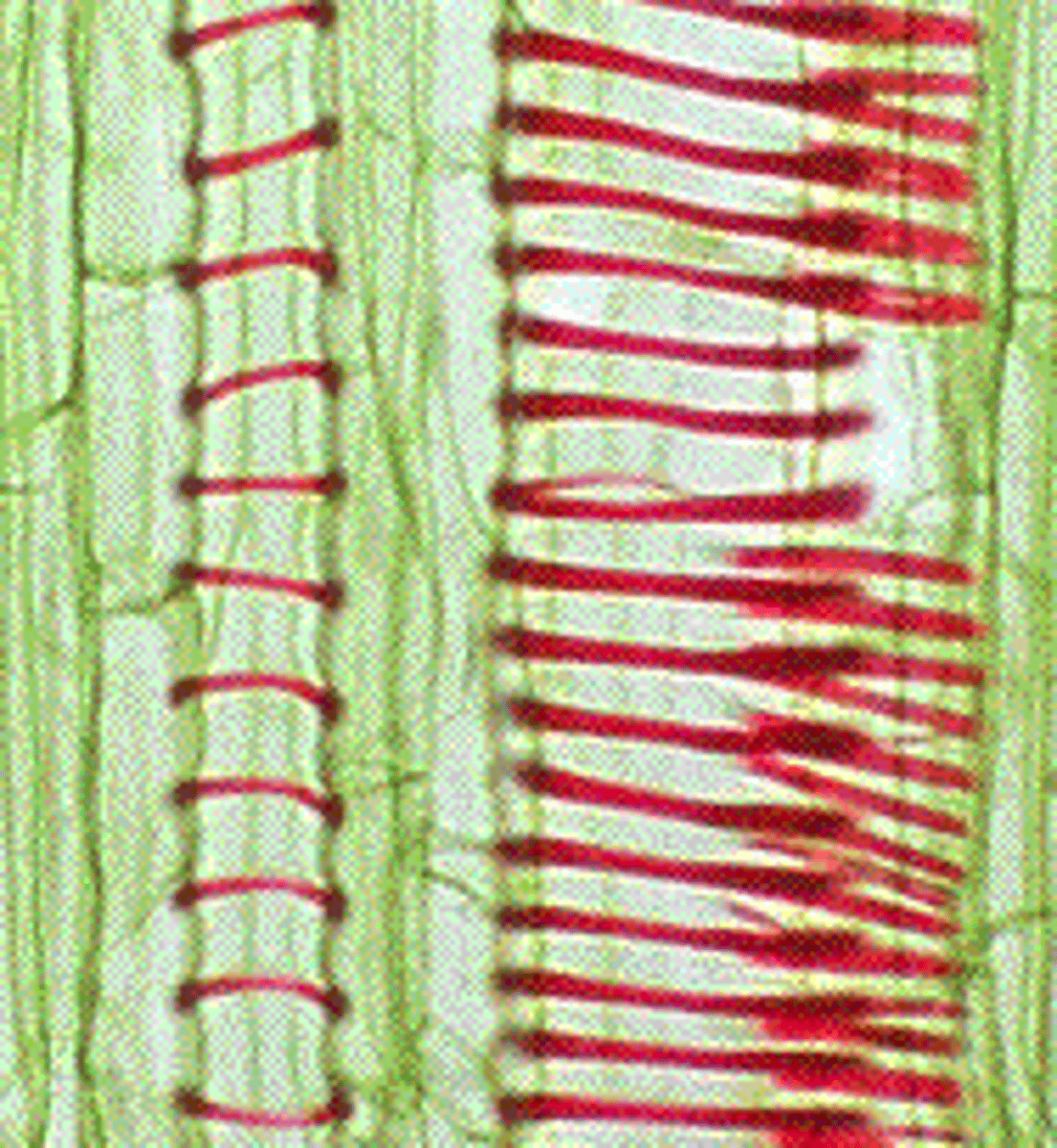
If you down a microscope at a xylem vessel from the top (perpendicular to the vessel),what will you see?
Large, empty circles
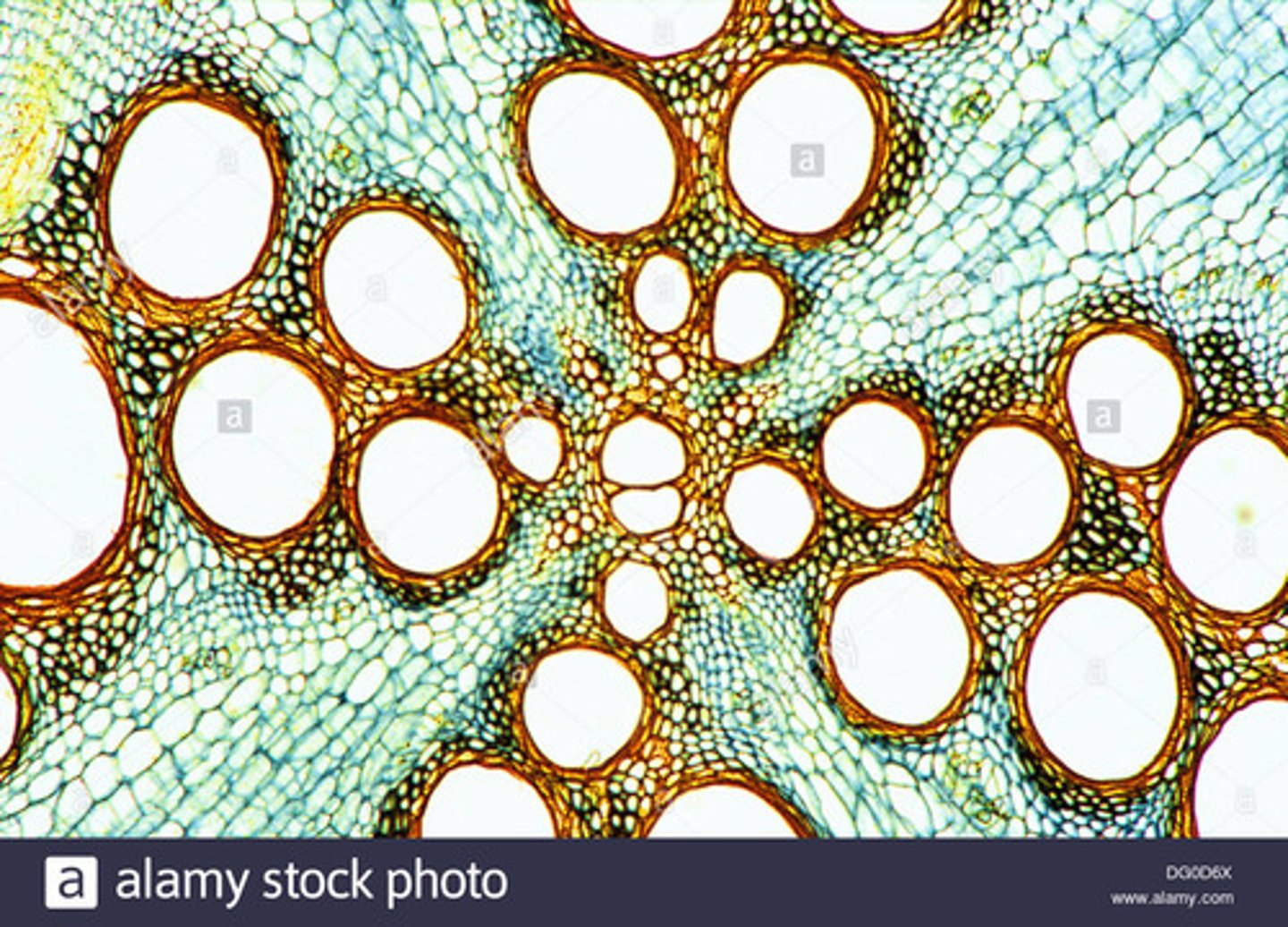
Describe the absorption of water by the root
- Soil water is not highly concentrated with mineral salts, so has a high water potential
- The vacuole and cytoplasm of the root hair cells are concentrated with solutes and so have low water potentials
- Water flows down its water potential gradient, into the root hair cells by osmosis
What are the 2 main routes that water takes to travel across the cells of the root cortex?
The apoplast pathway and the symplast pathway
Describe the apoplast pathway
Water travels through the cell walls of cells
Describe the symplast pathway
Water moves through the cytoplasm and plasmodesmata of cells
Why does water move from the root hair cells to the xylem?
There is a water potential gradient between the xylem and the root hair cells
The water potential is lower in the xylem, so water flows from the root hair cells to the xylem
Draw a diagram to show both the apoplast and symplast pathways together
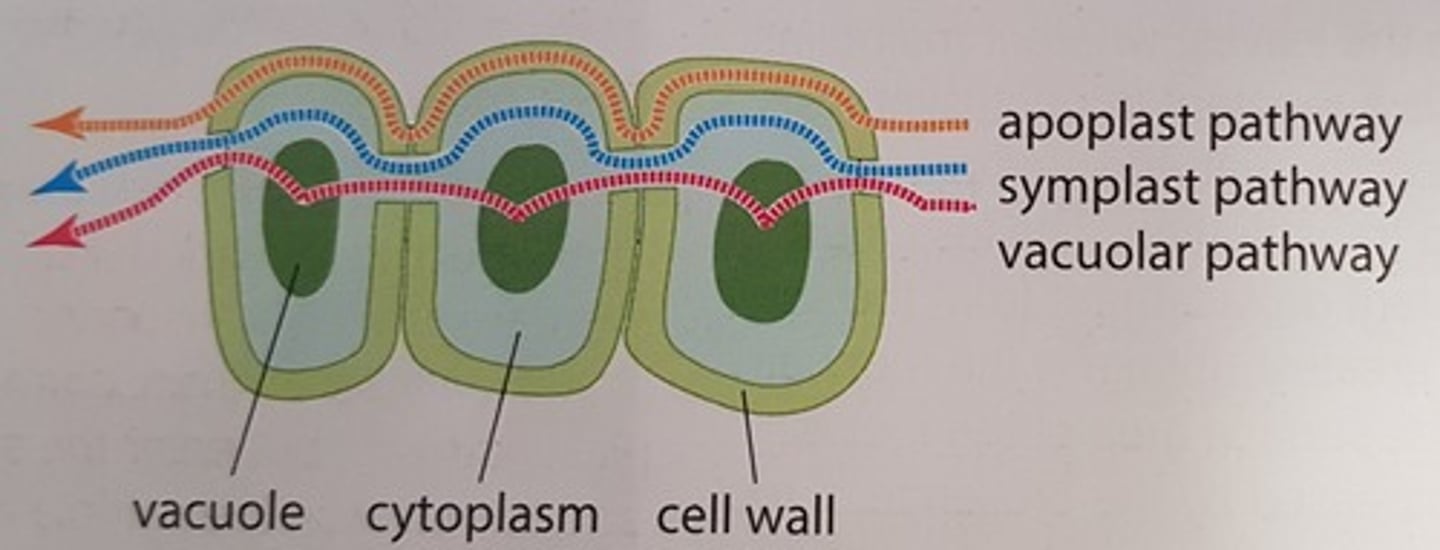
Which is faster, the apoplast pathway or the symplast pathway?
the apoplast pathway is faster
What is the endodermis?
A single layer of cells around the pericycle and vascular bundle of the root
What do all endodermal cells have that is significant to their function in water transport?
an impermeable waterproof barrier called the Casparian strip
What is the Casparian strip?
An impermeable waterproof barrier in the cell walls of endodermal cells (made from lipid chains)
What is the purpose of the Casparian strip?
It blocks the movement of water through the apoplast pathway, driving it into the cytoplasm
Describe how xylem vessels are developed
- Lignin builds up in the cell walls of cells
- The contents of the cell die, leaving an empty space (the lumen)
- The end walls of the cells break down, leaving a long hollow tube that water can be pulled through
Why do xylem vessels have a spiral pattern?
the lignin is laid down in the spiral pattern during development
How are xylem vessels adapted to their function?
- Their thick side walls are made of cellulose and lignin, which makes them strong and stiff - to give the plant support
- They are hollow to carry water
What is the Casparian strip made of?
A chain of lipids called suberin
True of False?
For transport of water into the xylem to be most efficient, the water potential of the epidermal cells must be high and the water potential of the xylem must be low
True
How is the water potential of the epidermal cells raised?
Water moving through the apoplast pathway is driven into the cells by the Casparian strip
How is the water potential of the xylem lowered?
Mineral salts are actively transported from the endodermis and surrounding cells into the xylem
What is root pressure?
The pressure created by water entering the xylem of a plant, causing an upward push
How does the plant take in mineral ions from the soil?
Either dissolved in the water that is taken in via osmosis, or actively transported into the cytoplasm of root cells
What are the two main mechanisms that move water up through the plant?
Cohesion-tension and root pressure
Define cohesion
Attraction between water molecules, as a result of hydrogen bonding
Define adhesion
Attraction between water molecules and hydrophillic molecules in the cell walls of the xylem
What is the cohesion-tension theory?
The theory of the mechanism by which water moves up the xylem, as a result of cohesion and adhesion of water molecules and the tension in the water column
Describe the cohesion-tension theory
- Water vapour evaporates from the leaf cells into the air
- This draws water across the cells of the leaf, through the different pathways
- As water molecules leave xylem cells in the leaf, they pull up other water molecules behind them due to cohesion between water molecules
- The continuous pull produces tension in the wter column
In the transpiration stream, water is drawn upwards by...
the cohesion between molecules and the adhesion between water molecules and the hydrophilic lining of the xylem vessels
Define transpiration
The evaporation of water vapour from the leaves (or other above ground parts of the plant), out through the stomata into the atmosphere
What is the downside of transpiration?
water loss
What are the benefits of transpiration
water uptake, water distribution, ion distribution, evaporative cooing
What are 5 factors affecting the rate of transpiration?
- Genetic factors (those controlling size, number and distribution of stomata)
- Temperature
- Humidity
- Air movement
- Light Intensity
How does temperature affect the rate of transpiration?
Higher temperatures lower the water potential of the atmosphere and increases the kinetic energy of water molecules - this increases the rate of evaporation of water molecules
The high temperature also causes water molecules to diffuse away from the leaf more quickly following evaporation (which decreases the water potential)
Increased temperature = more rapid transpiration
Draw a graph to show the effect of temperature on the rate of transpiration
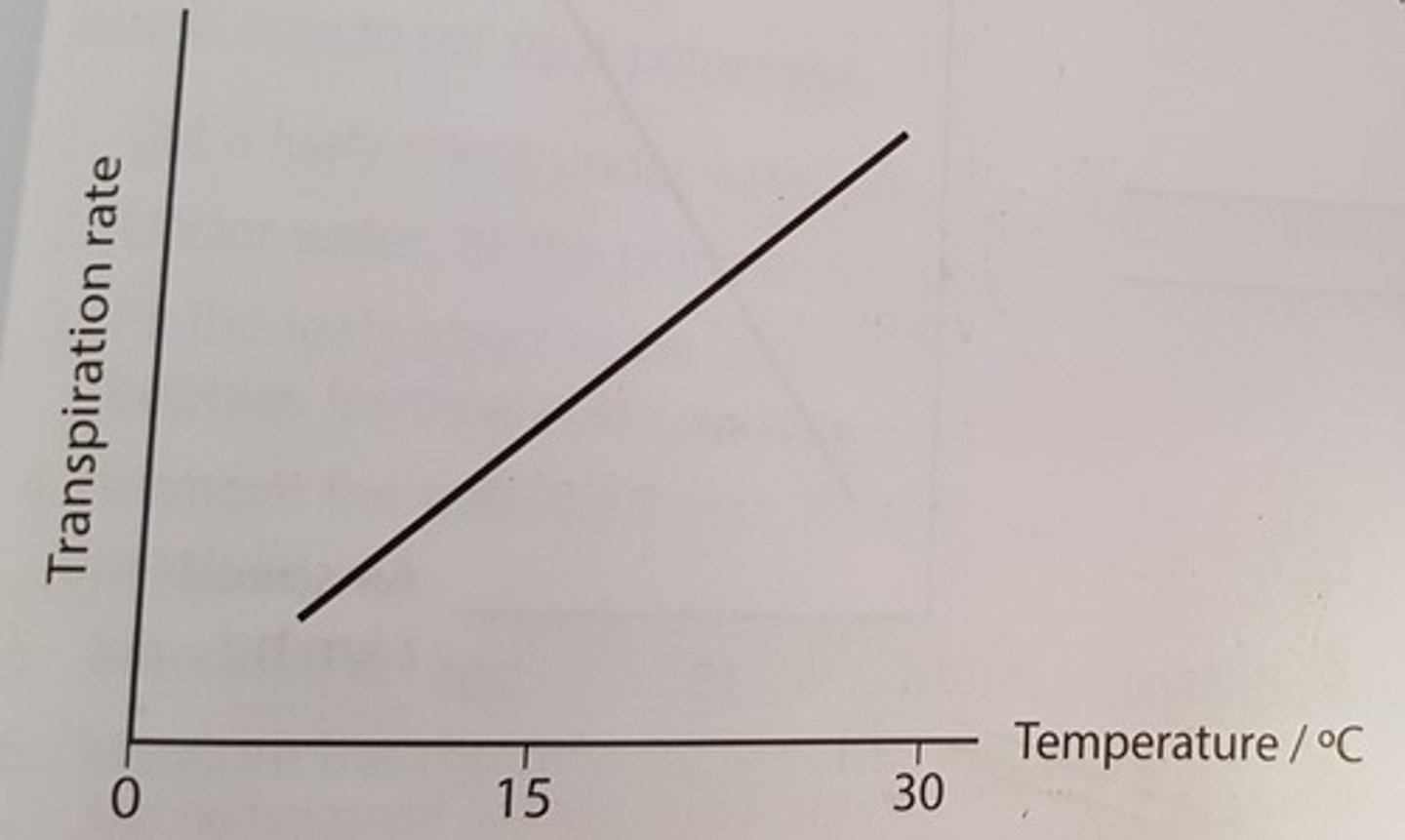
How does humidity affect the rate of transpiration?
Transpiration of water results in shells of water vapour surrounding the stomata. The water eventually diffuses away into the air, down its water potential gradient.
The higher the humidity, the higher the water potential. The water potential gradient between the inside of the leaf and the atmosphere is smaller. So with increased humidity, the rate at which water vapour diffuses away from the vapour shell decreases.
Increased humidity = less rapid transpiration
Draw a graph to show the effect of increasing humidity on the rate of transpiration
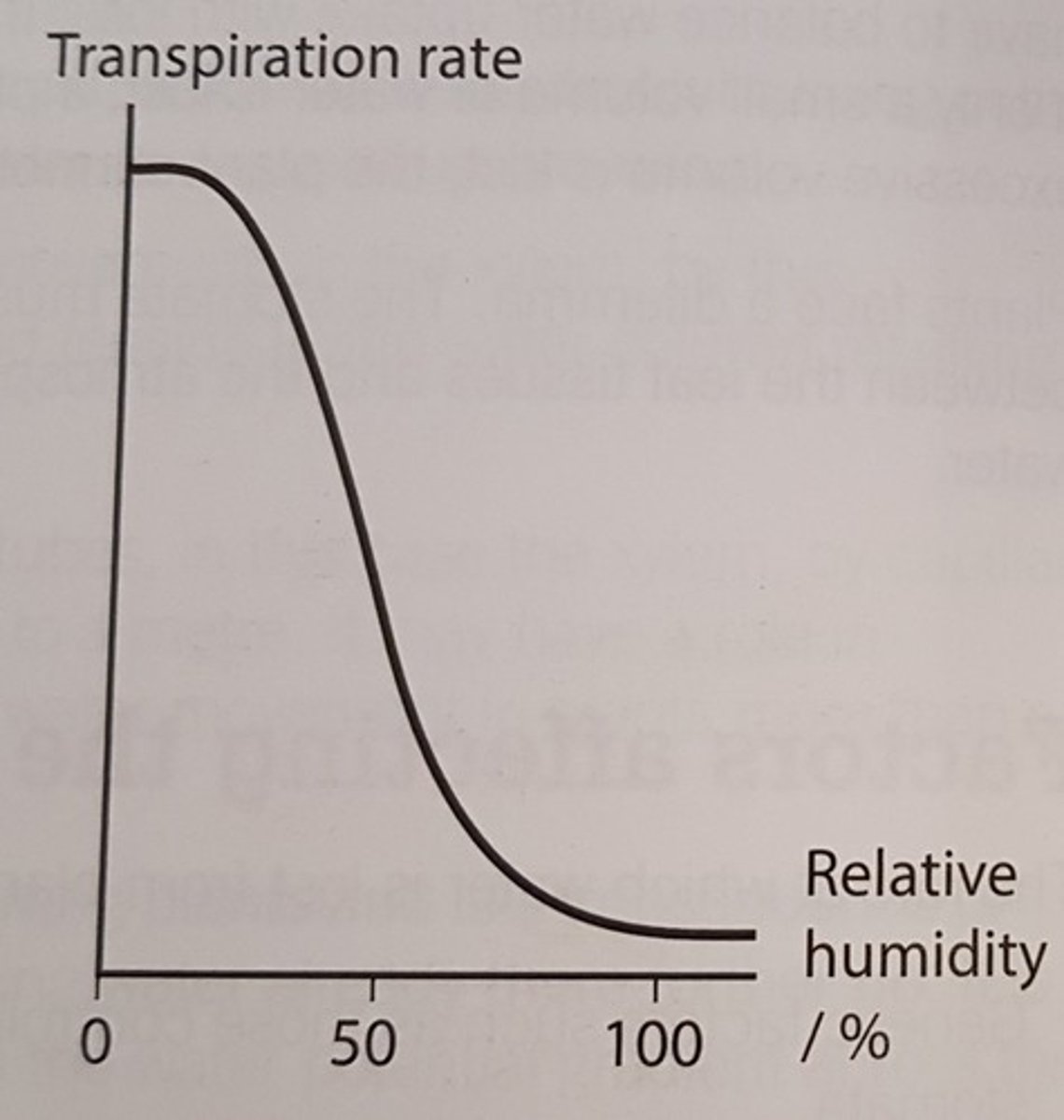
How does air movement effect the rate of transpiration?
Movement of air blows away the shells of water vapour surrounding the stomata at the surface of the leaf
The water potential gradient between the inside of the leaf and the atmosphere increases, causing water vapour to diffuse out through the stomata more rapidly
More air movement = more rapid transpiration
Draw a graph to show the effect of air movement on the rate of transpiration

How does light intensity effect the rate of transpiration?
Light intensity controls the degree of stomatal opening (increased light intensity = stomata opened wider)
The wider the stomata, the greater the rate of transpiration
What is a potometer?
An apparatus used to measure the rate of water uptake of a plant, which is directly linked to rate of transpiration
What are mesophytes?
Plants living in conditions of adequate water supplies
What are xerophytes?
Plants that live in conditions where water is scarce
What are hydrophytes?
Plants that live in water
How do mesophytes survive in unfavourable times of the year?
- They shed their leaves during winter, to prevent water loss by transpiration, when liquid water may be scarce
- The aerial parts of many non-woody plants die off in winter so they are not exposed to frost, but their underground organs survive
- Most annual mesophytes stay as dormant seeds over winter, with such a low metabolic rate that almost no water is required
Marram grass is a xerophyte that grows on sand dunes. Describe some of its adaptions and how they aid the plant
- Rolled leaves (this reduces the leaf area exposed to air, and so reduces transpiration)
- Sunken stomata (Humid air is trapped in the depressions, which reduces the water potential gradient between the inside of the leaf and the outside, so reduces the rate of diffusion out of the stomata)
- Hairs (they trap water vapour and reduce the water potential gradient between the inside of the leaf and the outside, so reduce the rate of diffusion out of the stomata)
- Thick cuticle (is waterproof so reduces water loss)
How are hydrophytes adapted?
- They use water as a supportive tissue so have little or no lignified support tissues
- They are surrounded by water, so have no need for transport tissue
- Leaves have little or no cuticle, because there is no need to prevent water loss
- Stomata are on the upper surface of floating leaves, because the lower surface is in the water
- Stems and leaves have large air spaces, forming a reservoir of oxygen and carbon dioxide, which provides buoyancy
Define translocation
The active movement of the soluble products of photosynthesis through phloem, from sources to sinks
What two cells make up the phloem?
Sieve tube elements and companion cells
Describe the structure of the phloem
The phloem is composed of tubes, made of cells called sieve tube elements. They are arranged end to end and have perforated end walls, called sieve plates. Companion cells surround the tubes, connected by plasmodesmata
Differences between xylem and phloem
- Xylem is comprised of dead cells, whereas phloem is living cells
- Movement in xylem is unidirectional, but bidirectional in phloem
- Xylem transports water and minerals, phloem transports soluble products of photosynthesis
-
What are some techniques that have been used to show that organic substances are translocated through the phloem?
- Ringing experiments
- Radioactive tracers and autoradiography
- Aphid experiments
- Aphids and radioactive tracers
Describe a ringing experiment and how they show that translocation occurs
Cylinders of outer bark tissue are removed from all around a woody stem, in a ring, removing the phloem. After some time, the area above the ring had swollen - concentrated with sucrose - and the area below had no sucrose. This suggests that sucrose is translocated in the phloem
Describe how radioactive tracers and an autoradiograph can be used to prove translocation occurs in the phloem
Use a radioactive isotope such as ¹⁴C in carbon dioxide. The plant will use this carbon dioxide in photosynthesis to synthesise sucrose. The positions of exposure on an autoradiograph coincide with the positions of the phloem, so sucrose must be transported in the phloem
Describe how aphid experiments were used to prove translocation occurs in the phloem
Aphids have long hollow mouthparts called stylets, which they insert into the sieve tubes to gain nutrients. The sap in the phloem is under pressure, so flows into the stylet of the aphid. The aphid is removed by the stylet remains, causing sap to flow out the top. This sap was analysed and showed the presence of sucrose
Translocation is the transport of organic solutes such as _________ and amino acids away from where they are made, the source, to other parts of the plant, where they are used for growth or storage, the _______. They are transported in the phloem cells called ________ ________ elements, which have no nucleus and are controlled by smaller, adjacent cells called ____________ cells.
sucrose
sink
sieve tube
companion
What is the main theory of translocation?
The mass flow hypothesis
Describe the mass flow hypothesis
- In source (leaf) sugars are actively transported into the phloem
- Active transport is done by companion cells
- This lowers water potential of sieve tube cells
- Water flows in via osmosis, increasing pressure
- Increase in pressure causes mass movement towards sink (root)
- Sugars diffuse out, and are used in sink for respiration or storage
What are the problems with the mass flow hypothesis?
- The rate of phloem transport is 10000 times faster than if it was just diffusion
- It does not take into account sieve plates
- Sucrose and amino acids move at different rates and in different directions at the same time
- Phloem has a relatively high oxygen consumption, and translocation is slowed when cyanide is applied
- The companion cells are biochemically very active, but the mass flow hypothesis does not suggest a role for them
What do other theories for translocation suggest about the process?
- That is is an active process
- Protein filaments pass through the sieve pores, so perhaps different solutes are carried along different routes through the same sieve tube element
- Cytoplasmic streaming is involved, making transport bidirectional
The ion concentration in a root hair cell is greater than in the soil water. Explain this difference
Ions are actively transported into the root hair cell from the soil
Explain why the water uptake from a potometer gives an estimate of the transpiration rate and not its true value
Some water is used in photosynthesis and some is produced by respiration. A potometer only measures the rate of water absorption, not transpiration
Explain how xylem tissue is adapted for its function (4)
- Waterproof
- Have no organelles
- Lignin for strength
- Pits in the walls to help water transfer
At 2 pm, the flow rate in the xylem of a tree was at its maximum. At the same time, the diameter of the tree trunk decreased. Use your knowledge of the cohesion-tension theory to suggest an explanation for this decrease
There is an adhesion force between the water molecules in the xylem and the walls of the xylem. This results in tension when water is pulled up the stem, causing an inwards pull on the walls
By what process is nitrate taken up into a plant?
Active transport
Explain why blockage of xylem vessels by the fungus Dutch Elm disease causes the wilting of leaves above the infection site and the death of elm trees (4)
- The direction of transport is towards the leaves
- The leaves cannot photosynthesise without water
- All the water inside the cells is used up in photosynthesis
- This causes the cells to shrink and the leaves will wilt